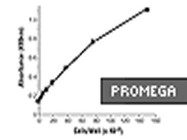
The CellTiter 96® AQueous One Solution Cell Proliferation Assay from Promega is a colorimetric method for determining the number of viable cells in culture. The solution contains a tetrazolium compound which when reduced produces a colored formazan product that is soluble in tissue culture medium and absorbs maximally at 490 nm. The compound is reduced due to the mitochondrial activity in the cell. The solution is simply added to the cells and over time, formazan is produced. The amount of formazan that is produced is directly proportionally to the number of viable cells. This assay can be used to test for cytotoxity; however, it should be noted that this assay does not indicate whether the cells are undergoing senescence or apoptosis and a secondary assay must be employed to determine this.
The MTS tetrazolium compound is bioreduced by cells into a colored formazan product that is soluble in tissue culture medium that absorbs maximally at 490 nm. Assays are performed by adding a small amount of the CellTiter 96® AQueous One Solution Reagent directly to culture wells, incubating for 1–4 hours and then recording the absorbance at 490nm with a 96-well plate reader.
The advantages of this assay are: (1) It can replace a [3H]-thymidine incorporation assay, (2) multiple readings can be taken over time (unlike the MTT assay), (3) a single, one-step solution is used for the assay, and (3) no organic solvents (unlike the MTT assay) are required.
The disadvantage is that the assay requires a lot of optimization up front. However, if you take the time to do this, you should not have to do it again. You must determine the number of cells needed as well as the incubation time required. I have found that 5,000 cells is a good starting point for a 96-well plate. Just as the manual states, I have found that lymphocyte cell lines (leukemic cell lines) require a lot more cells than other cell lines. I have found 20,000-40,000 cells to be the best. You also want to test the formazan formation over time to verify that you are in the linear range of the assay for the number of cells you use. If you take readings at 1 hour, 2 hours, 3 hours, and 4 hours, and determine (after background subtraction) that absorption for formazan production divided by the time of the reading you should get product/time and it should be about the same for all time points. I have found that with my cells plated at 5,000, I can take a reading at 2 hours and be in the linear range of the assay every time.
Also, make sure that you subtract background from your samples. Promega recommends subtracting a 630 nm reading from the 490 nm reading to account for the plastic, fingerprints, etc. I have done a comparison between not subtracting and subtracting and found that my numbers are much closer together in replicates after the subtraction. I also recommend performing quadruplicates and I have found that I can use 10 ul of the reagent instead of the 20 ul recommended, thereby doubling the amount of reagent purchased. Finally, I recommend using either a multi-channel pipette or a repeat pipettor for these assays (assuming you have one in your lab that is accurate, check before use.)
Assistant Professor
Department of Biological Sciences
San Jose State University